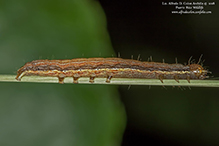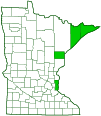Ursula wainscot
(Leucania ursula)
Conservation • Description • Habitat • Ecology • Distribution • Taxonomy
| Hodges # | 10461 |
||
Conservation Status |
|||
| IUCN Red List | not listed |
||
| NatureServe | NNR - Unranked |
||
| Minnesota | not listed |
||
Description |
Ursula wainscot is medium-sized owlet moth but a medium-large wainscot moth. It occurs in North America east of the Great Plains. In the United States it is common in the east and the Midwest. In Canada it occurs in Quebec and Ontario. It is uncommon in Minnesota, where it is at the western extent of its range. Adults are found from April to September. Larvae (caterpillars) are found on crabgrass and honeysuckle and possibly also on quackgrass and orchard grass. Adults are ¾″ (19 mm) long and have a wingspan of 1⅜″ (35 mm). The forewing is grayish-brown or yellowish-brown and is densely peppered with coarse dark scales. It is relatively unmarked, showing little of the streaking common on other wainscot moths. There is a circular spot (orbicular spot) in the upper median area and a kidney-shaped spot (reniform spot) at the end of the discal cell. Both spots are pale without a distinct border and without dark scales. The reniform spot has a small but conspicuous dark spot in the inner half. There is no club-shaped spot (claviform spot) near the inner margin. There are three dark horizontal lines; the antemedial (AM) line between the basal and median areas; the postmedial (PM) line that separates the median area from the postmedial area; and the terminal line at the outer margin. The AM line is scalloped but much broken and inconspicuous. The PM line is scalloped and broken but conspicuous. It consists of a dark dot on the veins and a crescent-shaped mark between the veins. The terminal line is a straight row of black dots, one at the end of each cell. There are three darker gray areas; one above the orbicular spot, one between the orbicular and reniform spots, and a faint, triangular one on the inner half of the wing tip. The hindwings are dark grayish-brown or yellowish-brown. The head and thorax are the same color as the forewings. On the upper side of the thorax there is a tuft of hairs that is dark just behind the head, otherwise the same color as the forewing. The antennae are threadlike on both the male and the female. The pair of small, finger-like processes (labial palps) curving up from the lower part of the head are the same color as the thorax and forewing. Males have a large and conspicuous tuft of hairs on the fourth segment (tibia) of the front leg. The larva (caterpillar) is 1 3 ⁄16″ to 1⅜″ (30 to 35 mm) long. |
Size |
Total length: ¾″ (19 mm) Wingspan: 1⅜″ (35 mm) |
Similar Species |
Habitat |
Old fields, wetlands |
Ecology |
Season |
Two generations per year: April to September |
Behavior |
Adults are active at night and will come to lights. |
Life Cycle |
|
Larva Hosts |
Crabgrass and honeysuckle, possibly also quackgrass and orchard grass |
Adult Food |
|
Distribution |
||
|
Sources 21, 24, 29, 30, 71, 75, 82, 83. Biodiversity occurrence data published by: Minnesota Biodiversity Atlas (accessed through the Minnesota Biodiversity Atlas Portal, bellatlas.umn.edu, 9/1/2025). |
|
| 9/1/2025 | ||
Occurrence |
||
Common in eastern United States, uncommon in Minnesota. |
||
Taxonomy |
|
Order |
Lepidoptera (Butterflies and Moths) |
Superfamily |
Noctuoidea (Owlet Moths and Allies) |
Family |
Noctuidae (cutworm moths and allies) |
Subfamily |
Noctuinae (cutworms and dart moths) |
Tribe |
Leucaniini (wainscot moths) |
Genus |
Leucania |
The genus Leucania was previously placed in the subfamily Hadeninae. |
|
Subordinate Taxa |
|
|
|
Synonyms |
|
|
|
Common Names |
|
ursula wainscot |
|
Glossary
Antemedial (AM) line
A thin line separating the basal area and the median area of the forewing of Lepidoptera.
Orbicular spot
A circular spot or outline in the upper median area near the antemedial line on the forewing of many moths.
Palp
Short for pedipalp. A segmented, finger-like process of an arthropod; one is attached to each maxilla and two are attached to the labium. They function as sense organs in spiders and insects, and as weapons in scorpions. Plural: palpi or palps.
Postmedial (PM) line
A thin line separating the median area and the postmedial area of the forewing of Lepidoptera.
Reniform spot
A kidney-shaped spot or outline in the lower median area near the PM line on the forewing of many moths.
Tibia
The fourth segment of an insect leg, after the femur and before the tarsus (foot). The fifth segment of a spider leg or palp. Plural: tibiae.
Visitor Photos |
Share your photo of this insect. |
||
This button not working for you? |
||
Alfredo Colon |
 |
MinnesotaSeasons.com Photos |
|

Slideshows |
|

Visitor Videos |
Share your video of this insect. |
||
This button not working for you? |
||
|
Other Videos |
|

|
Created: 12/19/2019 Last Updated: © MinnesotaSeasons.com. All rights reserved. |


